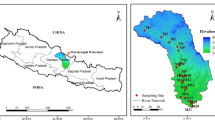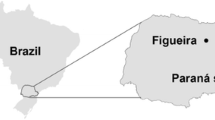Abstract
Alpine lakes in siliceous catchments of Tyrol and Carinthia (Austria) show signs of acidification. About 9% of the studied lakes have no alkalinity, more than 20% are below pH 6. About two thirds of all lakes have acid neutralizing capacities below 100 μeq 1−1. In spite of moderate precipitation acidity, some lakes show considerable concentrations of dissolved reactive aluminum during or shortly after snowmelt. High altitude lakes of the Alps are definitely more acidic than high mountain lakes in remote areas. Large differences in water and soil chemistry of nearby situated lakes were attributed to heterogeneities of bedrock geology. Paleolimnological investigations on former pH values of five lakes, based on diatom assemblages in the sediment, showed different developments: recent and past acidification, stable conditions, and alkalinization.
Similar content being viewed by others
References
Arzet, K.: Diatomeen als pH-Indikatoren in subrezenten Sedimenten von Weichwasserseen. Diss. Abteil. Limnol. Innsbruck24 1–266 (1987).
Barbieri, A., and Righetti, G.: Chimica delle deposizioni atmosferiche nel canton Ticino ed effetti sulle acque dei laghi alpini d'alta quota. Docum. Ist. Ital. Idrobiol.14 19–34 (1987).
Bendetta, G.: Umweltbelastungen durch Luftverunreinigungen in Südtirol.In: Grill, D., and Guttenberger, H. (eds), Ökophysiologische Probleme durch Luftverunreinigungen. Inst. f. Pflanzenphysiologie, Univ. Graz (1988).
Dougan, W. K., and Wilson, A. L.: The absorptimetric determination of aluminum in water. A comparison of some chromogenic reagents and the development of an improved method. Analyst99 413–430 (1974).
Eilers, J., Kanciruk, P., McCord, R. A., Overton, W. S., Hook, L., Blick, D. J., Brakke, D. F., Kellar, P. E., DeHaan, M. D., Silverstein, M. E., and Landers, D. H.: Characteristics of lakes in the Western United States. Volume II. Data compendium for selected physical and chemical variables. EPA/600/3-86/054b, U. S. Environmental Protection Agency, Washington (1987).
Eppacher, T.: Physiographie und Zooplankton des Gossenköllesees (2413 m, Kühtai, Österreich). Ber. nat.-med. Ver. Innsbruck56 31–123 (1968).
Ganthaler, O.: Eisenkreislauf und Eisenbakterien im Pelagial des Piburger Sees (Ötztal, Tirol). Diss. Abt. Limnol. Innsbruck6 1–167 (1977).
Golterman, H. L., Clymo, R. S., and Ohnstad, M. A. M.: Methods for chemical analysis of fresh waters. IBP Handbook No. 8, 2nd ed. Oxford, Blackwell (1978).
Gruppo di Studio sulle Caratteristiche Chimiche delle Precipitazioni: Deposizioni atmosferiche nel Nord Italia. Rapporto finale anni 1983–1984. Ingegneria Ambientale, Inquinamento e Depurazione6 4–63 (1987).
Henriksen, A.: Alkalinity and acid precipitation research. Vatten38 83–85 (1982).
Henriksen, A., Dickson, W., and Brakke, D.: Estimates of critical loads for sulfur to surface water.In: Nilsson, J. (ed.), Critical loads for sulfur and nitrogen. Report from a Nordic Working Group, pp. 87–120 (1986).
Honsig-Erlenburg, W., and Psenner, R.: Zur Frage der Versauerung von Hochgebirgsseen in Kärnten. CarinthiaII, 176/96, 443–461.
Kahl, J. S.: High elevation lake monitoring in Maine 1986. Maine Dept. of Environm. Prot., Univ. of Maine, Orono Maine, 1–2 (1987).
Kahn, L.: Automatic determination of chloride in freshwater and estuarine environments. Automation in Analytical Chemistry1 369–375 (1967).
Koroleff, F.: Determination of total nitrogen in natural waters by means of persulfate oxidation. Int. Counc. Explor. Sci. (ICES) Paper C. M. 1969/c, 8–11 (1969).
Landers, D. H., Eilers, J. M., Brakke, D. F., Overton, W. S., Kellar, P. E., Silverstein, M. E., Schonbrod, R. D., Crowe, R. E., Linthurst, R. A., Omernik, J. M., Teague, S. A., and Meir, E. P.: Characteristics of lakes in the Western United States. Volume I. Population descriptions and physico-chemical relationships. EPA/600/3-86/054a U. S. Environmental Protection Agency, Washington (1987).
Lazrus, A. L., Hill, K. C., and Lodge, J. P.: Automated determination of sulfate in natural waters. Proc. 1965 Technicon Symp. “Automation in Analytical Chemistry”, Medicad Inc. pp. 291–297 (1966).
Leutelt-Kipke, S.: Ein Beitrag zur Kenntnis der hydrographischen und hydrochemischen Verhältnisse einiger Tiroler Hoch- und Mittelgebirgsseen. Arch. Hydrobiol.27 286–352 (1934).
Mosello, R.: Hydrochemistry of high altitude alpine lakes. Schweiz. Z. Hydrol.46 86–99 (1984).
Mosello, R.: Effects of acid depositions on subalpine and alpine lakes in NW Italy. Mem. Ist. Ital. Idrobiol.74 117–146 (1986).
Mosello, R., Marchetto, A., Bovio, M., Castello, P., and Tartari, G. A.: Susceptibility to acidification of high altitude lakes in Val d'Aosta (Western Alps, N. Italy).In: Perry, P., Harrison, R. M., Bell, J. N. B., and Lester, J. N. (eds.), Acid rain: scientific and technical advances. Selper, London, pp. 317–322 (1987).
Mosello, R., and Tartari, G.: Effects of acid precipitation on subalpine lakes. Water Quality Bulletin8 96–100 (1983).
Nauwerck, A.: Vattenkemi och plankton i sjöar i Abiskoomradet, Augusti 1981. Länsstyrelsen i Norrbottens Län, Planeringsavdelningens rapportserie14 1–26 (1983).
Nygaard, G.: The ancient and recent flora of diatoms and chrysophyceae in Lake Gribsø. Folia Limnol. Scand.8 32–94; 253–262 (1956).
Pesta, O.: Hochgebirgsseen und ihre Fauna. I. Beitrag. Verh. zool. bot. Ges. Wien62 158–171 (1912).
Psenner, R., Arzet, K., Brugger, A., Franzoi, J., Hiesberger, F., Honsig-Erlenburg, W., Horner, F., Nickus, U., Pfister, P., Schaber, P., and Zapf, F.: Versauerung von Hochgebirgsseen in kristallinen Einzugsgebieten Tirols und Kärntens. Zustand, Ursachen, Auswirkungen, Entwicklung. Wasserwirtschaft Wasservorsorge, Forschungsarbeiten. Bundesmin. f. Land- u. Forstwirtschaft, Wien, pp. 1–355 (1988).
Psenner, R., and Nickus, U.: Snow chemistry of a glacier in the Central Eastern Alps (Hintereisferner, Tyrol, Austria). Z. Gletscherkunde u. Glazialgeologie22 1–18 (1986).
Renberg, I., and Hellberg, T.: The pH-history of lakes in southwestern Sweden, as calculated from the subfossil diatom flora of the sediment. Ambio11 30–33 (1982).
Schindler, D. W., Mills, K. H., Malley, D. F., Findlay, D. L., Shearer, D. A., Davies, I. J., Turner, M. A., Linsey, J. A., and Cruikshank, D. R.: Long-term ecosystem stress: the effect of years of experimental acidification on a small lake. Science228 1395–1401 (1985).
Schnoor, J. L., and Stumm, W.: Acidification of aquatic and terrestrial systems.In: Stumm, W. (ed.), Chemical processes in lakes. Wiley Interscience, pp. 311–363 (1985).
Schnoor, J. L., and Stumm, W.: The role of chemical weathering in the neutralization of acid deposition. Schweiz. Z. Hydrol.48 171–195 (1986).
Schotterer, U., Oeschger, H., Wagenbach, D., and Münnich, K. O.: Information on paleoprecipitation on a high-altitude glacier (Monte Rosa, Switzerland). Z. Gletscherkunde u. Glazialgeologie21 379–388 (1984).
Stainton, M. P., Capel, M. J., and Armstrong, F. A. J.: The chemical analysis of freshwater. Fish. Res. Bd. Can. Misc. Spec. Publ.25 1–125 (1974).
Stumm, W., Morgan, J. J., and Schnoor, J. L.: Saurer Regen, eine Folge der Störung hydrogeochemischer Kreisläufe. Naturwissenschaften70 216–223 (1983).
Stumm, W., and Righetti, G.: Tessiner Bergseen: saurer Regen, saure Traufe. Neue Zürcher Zeitung231 31 (1982).
Talling, J. F.: The application of some electrochemical methods to the measurement of photosynthesis and respiration in fresh waters. Freshwater Biol.3 335–362 (1973).
Thaler, B., and Tait, D.: Chemismus von Hochgebirgsseen in Südtirol. Tätigkeitsbericht des Biologischen Landeslabors. Südtiroler Landesregierung, Bozen, Italien (1987).
Turnowski, F.: Die Seen der Schobergruppe in den Hohen Tauern. Carinthia II, Klagenfurt, Sonderheft8 1–78 (1946).
Vogler, P.: Probleme der Phosphoranalytik in der Limnologie und ein neues Verfahren zur Bestimmung von Orthophosphat neben kondensierten Phosphaten und organischen Phosphorsäureestern. Int. Rev. ges. Hydrobiol.50 33–48 (1965).
Wagner, R.: Neuere Aspekte zur Stickstoffanalytik in der Wasserchemie. Vom Wasser36 263–281 (1969).
Zobrist, J., Sigg, L., Schnoor, J. L., and Stumm, W.: Buffering mechanisms in acidified alpine lakes.In: Barth, H. (ed.), Reversibility of acidification. Elsevier London, pp. 95–103 (1987).
Author information
Authors and Affiliations
Rights and permissions
About this article
Cite this article
Psenner, R. Chemistry of high mountain lakes in siliceous chatchments of the Central Eastern Alps. Aquatic Science 51, 108–128 (1989). https://doi.org/10.1007/BF00879298
Received:
Accepted:
Issue Date:
DOI: https://doi.org/10.1007/BF00879298




